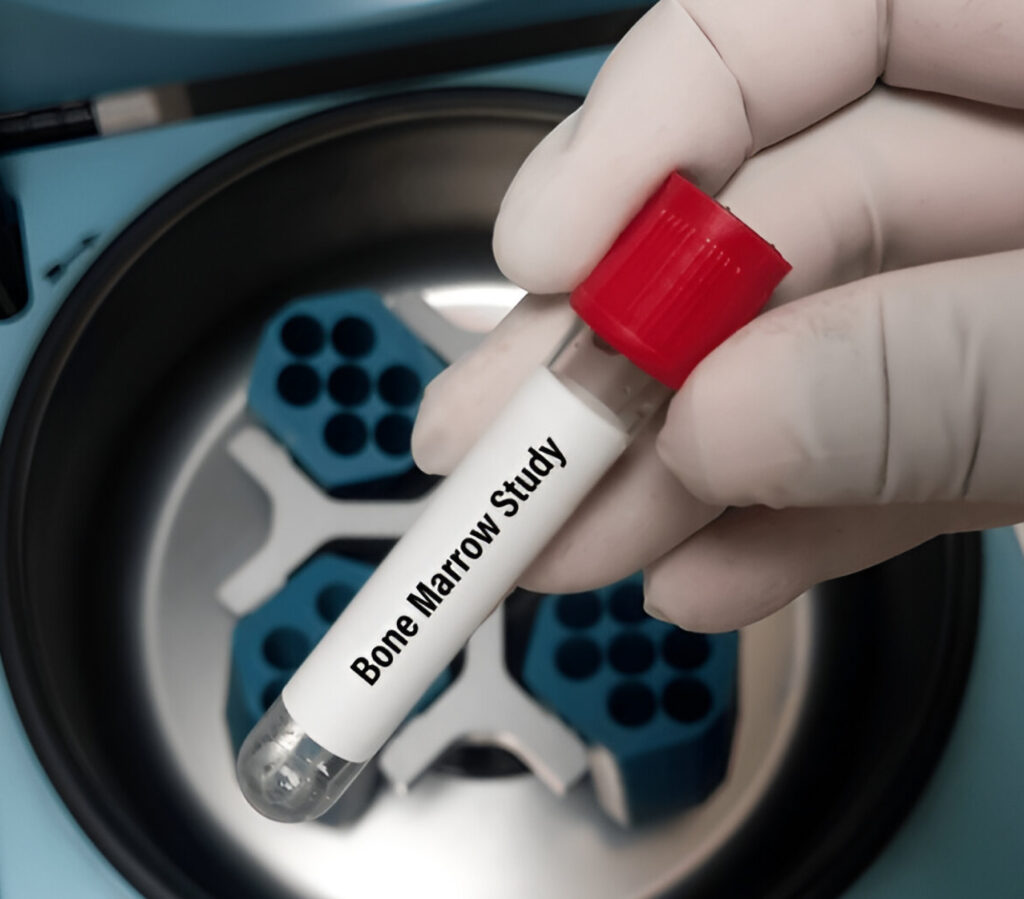Multiple myeloma treatment
Multiple Myeloma
Multiple Myeloma care at Thangam cancer center
Multiple Myeloma is a type of blood cancer that affects plasma cells, a kind of white blood cell found in the bone marrow. These cells normally help fight infections by making antibodies. In multiple myeloma, abnormal plasma cells multiply uncontrollably and interfere with the body’s ability to fight infections, maintain bone health, and produce healthy blood cells.
At Thangam Hospital, our expert oncology team delivers personalized, evidence-based treatment for multiple myeloma using advanced diagnostics, cutting-edge therapies, and compassionate care. From early detection to long-term management, we stand by you at every step of your cancer journey.


What Is Multiple Myeloma?
Multiple myeloma begins in the bone marrow, where abnormal plasma cells build up, crowding out healthy blood cells and releasing harmful proteins that can damage bones and organs. It is more common in older adults and tends to progress slowly, although it can become aggressive if untreated.
Common Symptoms of Multiple Myeloma
Many patients may not experience noticeable symptoms in the early stages. As the disease progresses, symptoms may include:

Persistent bone pain, especially in the back or ribs

Unexplained fatigue or weakness

Increased thirst and urination (due to high calcium levels)

Anemia or frequent bruising/bleeding

Frequent infections

Weight loss

Nausea or constipation

Kidney problems
How We Diagnose Multiple Myeloma at Thangam Hospital
Early and accurate diagnosis is key to effective treatment. Our team uses advanced diagnostic tools, including:
Blood Tests
To detect abnormal proteins (M-protein), anemia, and calcium levels
Urine Tests
To look for Bence-Jones proteins
Bone Marrow Biopsy
To assess the number and type of plasma cells
Imaging Tests
MRI, CT scans, and X-rays to check for bone damage


Risk Factors for Multiple Myeloma
Age
Most cases occur in individuals over 60 years old.
Gender
Men are more likely to develop multiple myeloma than women.
Race
African descent populations have a higher incidence.
Family history
Risk increases if a close relative has the disease.
Personal history of monoclonal gammopathy
A benign condition that can progress to myeloma.
Obesity
Excess body weight may increase risk.
Radiation exposure
Prior exposure to radiation may contribute to disease development.
Weakened immune system
Conditions that impair immunity may raise susceptibility.
Treatment Options for Multiple Myeloma
Our approach to treatment depends on the stage, symptoms, and overall health of the patient. Common treatments include:
- Targets specific genes, proteins, or the tumor microenvironment that promote myeloma cell growth and survival.
- Proteasome Inhibitors:
- Bortezomib (Velcade), carfilzomib (Kyprolis), ixazomib (Ninlaro).
- Histone Deacetylase Inhibitor:
- Panobinostat (Farydak) for recurrent myeloma.
- Monoclonal Antibodies:
- Elotuzumab (Empliciti), daratumumab (Darzalex) help the immune system eliminate myeloma cells.
- Nuclear Export Inhibitor:
- Selinexor (Xpovio) with dexamethasone for relapsed/refractory myeloma.
- BCMA Antibody-Drug Conjugate:
- Belantamab mafodotin-blmf (Blenrep) for heavily treated patients.
- Some targeted agents like thalidomide, lenalidomide, and bortezomib are also used in maintenance therapy post-transplant to extend response duration.
Immunomodulatory Drugs:
- Thalidomide, lenalidomide (Revlimid), pomalidomide (Pomalyst) stimulate immune response and block blood supply to myeloma cells.
- Approved for both newly diagnosed and relapsed cases.
Steroids:
- Dexamethasone and prednisone are often combined with other therapies to reduce plasma cells, though their effect is temporary.
- Uses drugs to kill fast-dividing cancer cells, often in cycles over a set time period.
- Administered orally or via IV, often in combination regimens tailored to patient needs.
- Common agents include:
- Cyclophosphamide, doxorubicin, melphalan, etoposide, cisplatin, carmustine, and bendamustine.
- Melphalan is frequently used prior to stem cell transplantation.
- Side effects may include fatigue, infection risk, nausea, appetite loss, neuropathy, and low blood counts—often subside post-treatment.
- Chemotherapy continues until the myeloma is brought under control
- Replaces diseased bone marrow with healthy hematopoietic stem cells.
- Two types:
- Autologous (AUTO): Patient’s own stem cells—most commonly used.
- Allogeneic (ALLO): Donor stem cells—under clinical trials.
- Involves high-dose chemotherapy (often melphalan) to eliminate myeloma cells before transplant.
- Infused stem cells regenerate healthy bone marrow and blood cells.
- Typically performed when the patient is in remission.
- High-energy X-rays used to destroy cancer cells, especially in bone lesions.
- Recommended when:
- Chemotherapy is ineffective for bone pain.
- Localized plasmacytomas need control.
- Delivered in a scheduled regimen based on patient need.
- Also called palliative care, aims to manage physical, emotional, and social effects of cancer.
- Offered alongside curative treatment to:
- Reduce symptoms and side effects.
- Improve quality of life and treatment satisfaction.
- Medications, dietary adjustments, relaxation techniques, and emotional/spiritual support.




